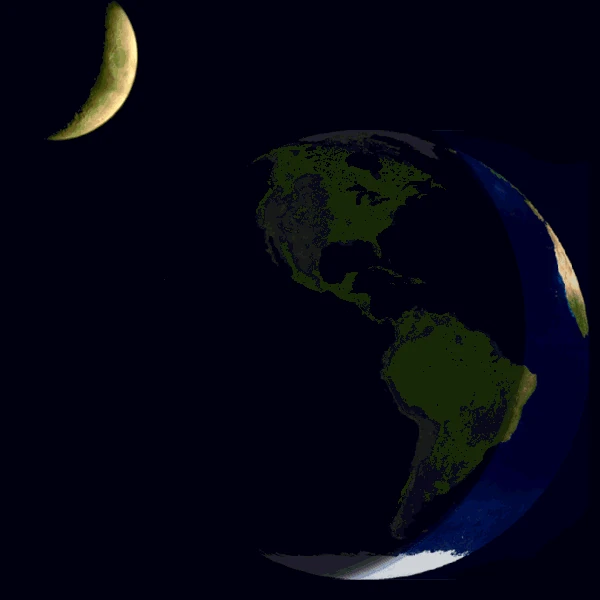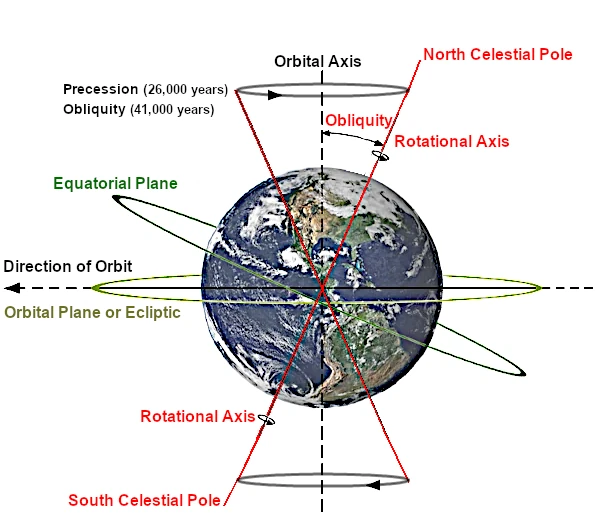
The Earth's rotation on its axis is not constant over geological time scales. Paleontological analyses of fossil corals and stromatolites indicate that 400 million years ago, an Earth year consisted of about 420 days. This phenomenon is explained by fundamental physical laws related to the conservation of angular momentum and the gravitational interaction between the Earth and the Moon.
The main driver of the slowdown is the tidal force exerted by the Moon. This force creates a deformation of the solid and fluid Earth. Due to the viscosity of the Earth's mantle and the inertia of the oceans, this tidal bulge does not point directly towards the Moon but slightly ahead, generating a braking torque. This torque tends to transfer the angular momentum of the Earth's rotation to the Moon's orbital motion, which then gradually moves away from us (about 3.8 cm/year).
This energy transfer involves thermal dissipation (mainly in the oceans) and causes a slowdown in the Earth's rotation. The average length of the day is currently increasing by about 1.7 milliseconds per century. This variation may seem small, but accumulated over millions of years, it becomes significant.
The Earth rotates on its axis around an imaginary axis, tilted and oriented towards the north celestial pole. At the equator, this rotation generates a surface speed of about 1674.364 km/h. Long considered a universal reference base, this rotation was used to measure time accurately. But in reality, this speed is neither constant nor perfectly regular: the Earth experiences subtle but measurable fluctuations, leading to time desynchronizations.
Since the 1960s, these irregularities have resulted in the addition of leap seconds to compensate for the gradual slowdown of the rotation. In total, 34 seconds have been added to maintain the alignment between atomic time and astronomical time. Thus, some minutes last 61 seconds. This phenomenon, although marginal in the short term, highlights the constant need to reevaluate our definition of time.
The instability of the Earth's rotation is due to a set of internal and external factors. The Earth is not a perfectly rigid body: its different layers — metallic core, mantle, crust, atmosphere — interact dynamically and asynchronously. The Moon, through its tidal effects, has acted for billions of years as a natural brake on the rotation of the Earth's mantle. But other bodies in the solar system, such as planets and the Sun, also contribute to this slowdown through gravity.
Punctual geophysical phenomena also modulate the length of the day: continental drift, major earthquakes, ocean currents, intense meteorological events. These effects can accelerate or slow down the rotation by a few microseconds. Our planet is actually "tossed" on the four-dimensional fabric of spacetime, a cosmic trampoline bent by the mass of the stars. These chaotic gravitational flows, predicted by general relativity, permanently influence the inertial behavior of the Earth.
In 1967, the second was redefined atomically, based on 9,192,631,770 oscillations of the cesium-133 atom. But this definition does not perfectly divide the sidereal or solar day. A tiny error remains, amplified by the natural variations mentioned above.
These fluctuations make it necessary to continuously monitor the length of the day. Time measurement systems must be regularly resynchronized to ensure temporal consistency between terrestrial and spatial instruments. This precision is crucial for modern technologies, particularly for global navigation systems like GPS. At 20,000 km altitude, a delay of a few microseconds in time calculation would result in a positioning error of several hundred meters on the Earth's surface.
For this reason, organizations like the IERS (International Earth Rotation and Reference Systems Service) continuously monitor variations in the Earth's rotation. These observations allow periodic adjustments to global legal time and ensure the reliability of time-dependent systems.
Since 1972, Coordinated Universal Time (UTC) has been occasionally adjusted by adding leap seconds to compensate for the irregular slowdown of the Earth's rotation relative to atomic time. This additional second is inserted unpredictably, typically at the end of June or December, to keep the difference between UTC and Universal Time UT1 below 0.9 seconds. Although scientifically justified, this process proves problematic for global computer systems.
The insertion of a leap second causes a temporal discontinuity. Many global computer systems and networks, particularly those used for satellite navigation (GNSS), financial transactions, or telecommunication infrastructures, operate with a requirement for continuous, strictly monotonic time. The sudden addition of a second breaks this continuity and can lead to synchronization errors, service interruptions, or even critical failures.
Major incidents have been reported several times during the insertion of these seconds: server crashes, GPS system freezes, embedded software malfunctions. The increasing complexity of global synchronization makes this operation increasingly costly and risky. In 2012, for example, a leap second caused outages in airline and social network systems, illustrating the growing inadequacy of this method with modern digital needs.
Faced with these challenges, the International Telecommunication Union (ITU) and the International Bureau of Weights and Measures (BIPM), with the agreement of the major scientific powers, voted in November 2022 to abandon leap seconds from 2035. The UTC system will then gradually become desynchronized from astronomical time (UT1), but this drift will be slow: about one second every 50 to 100 years, depending on the evolution of the Earth's rotation.
This technical compromise ensures perfect continuity of time for digital systems, while leaving it to future generations to decide, in the longer term, on any possible readjustment. There is already talk of the possibility of a much more spaced adjustment, for example, of a full minute every 500 or 1000 years. This historic change marks a break between civil time and astronomical time but reflects the need for a temporal convention adapted to the digital age.

The measurement of the Earth's rotation relies on a combination of high-precision astronomical, geodetic, and physical methods. Historically, it is the observation of celestial bodies, particularly the Sun and stars, that has allowed the definition of the day. Today, modern techniques allow the measurement of variations in the length of the day with a precision down to the microsecond.
The oldest method is based on sidereal time, i.e., the time between two successive passages of the same star at the local meridian. This rotation period, called the sidereal day, lasts about 23 hours 56 minutes 4.0905 seconds. It is slightly shorter than the mean solar day, which lasts 24 hours, due to the Earth's revolution around the Sun. The comparison between these two times reveals subtle differences in the Earth's rotation.
Since the mid-20th century, the advent of the atomic clock has revolutionized time metrology. The second is now defined absolutely, based on the hyperfine oscillations of the cesium-133 atom. In 1967, the General Conference on Weights and Measures (CGPM) set this definition at 9,192,631,770 oscillations per second. International Atomic Time (TAI) has thus become the absolute reference for physical time.
The comparison between TAI and the actual rotation of the Earth (measured by astronomical techniques) allows the detection of discrepancies. These discrepancies are compiled into a corrected universal time, called UTC (Coordinated Universal Time), to which leap seconds are added or subtracted when the difference between TAI and UT1 exceeds 0.9 seconds.
The Earth's rotation is also measured by space geodetic techniques such as VLBI (Very Long Baseline Interferometry), which uses radio signals emitted by very distant quasars to determine the exact position of terrestrial stations at different latitudes. This technique is capable of detecting tiny variations in the Earth's orientation, including nutation, precession, and polar motion.
Other tools contribute to the precise measurement of the Earth's rotation:
Finally, the International Earth Rotation and Reference Systems Service (IERS) coordinates all these measurements and regularly publishes the Earth's rotation parameters, essential for scientific applications, telecommunications, astronomy, and space navigation.
The slowdown of the Earth's rotation has several physical, astronomical, and climatic consequences. In the very long term (several billion years), if the trend continues, the Earth could reach a state of synchronous rotation with the Moon: an Earth day would then last as long as a lunar month, and the Moon would remain visible from only one terrestrial hemisphere, as is already the case inversely for us.
In parallel, this slowdown is integrated into time measurement systems. Universal Time (UT1), based on the Earth's rotation, slowly diverges from International Atomic Time (TAI). To maintain this coherence, leap seconds are added irregularly to Coordinated Universal Time (UTC). However, this process will be abandoned from 2035 due to its complexity for global digital systems.
Finally, on larger scales, the dissipation of tidal energy plays an important role in the dynamic evolution of planetary systems. This mechanism, called tidal friction, also affects exoplanetary systems, particularly in the gravitational locking of certain exoplanets with respect to their star.